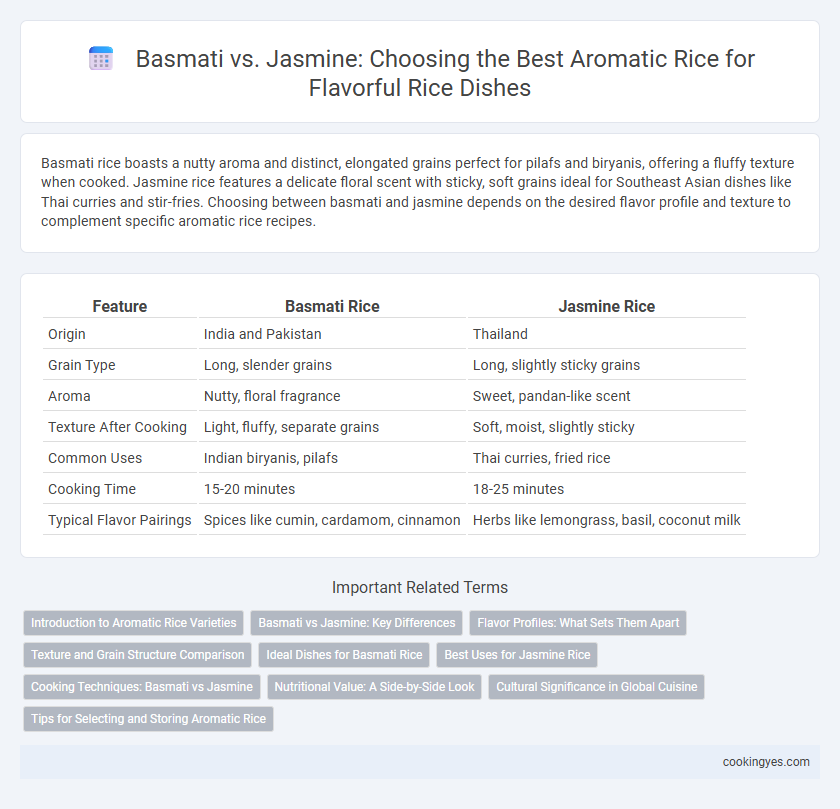Basmati rice boasts a nutty aroma and distinct, elongated grains perfect for pilafs and biryanis, offering a fluffy texture when cooked. Jasmine rice features a delicate floral scent with sticky, soft grains ideal for Southeast Asian dishes like Thai curries and stir-fries. Choosing between basmati and jasmine depends on the desired flavor profile and texture to complement specific aromatic rice recipes.
Table of Comparison
| Feature | Basmati Rice | Jasmine Rice |
|---|---|---|
| Origin | India and Pakistan | Thailand |
| Grain Type | Long, slender grains | Long, slightly sticky grains |
| Aroma | Nutty, floral fragrance | Sweet, pandan-like scent |
| Texture After Cooking | Light, fluffy, separate grains | Soft, moist, slightly sticky |
| Common Uses | Indian biryanis, pilafs | Thai curries, fried rice |
| Cooking Time | 15-20 minutes | 18-25 minutes |
| Typical Flavor Pairings | Spices like cumin, cardamom, cinnamon | Herbs like lemongrass, basil, coconut milk |
Introduction to Aromatic Rice Varieties
Basmati and Jasmine are two prominent aromatic rice varieties distinguished by their unique fragrance and texture, making them essential in various culinary traditions. Basmati rice, native to the Indian subcontinent, is known for its long grains and nutty aroma, ideal for biryanis and pilafs. Jasmine rice, primarily cultivated in Thailand, features slightly shorter grains with a floral scent and soft, sticky texture perfect for Southeast Asian dishes.
Basmati vs Jasmine: Key Differences
Basmati rice, primarily grown in the Indian subcontinent, is known for its long grains and nutty aroma, making it ideal for biryanis and pilafs. Jasmine rice, native to Thailand, features shorter, slightly sticky grains with a floral fragrance, complementing Southeast Asian cuisines like Thai curries. Texture and aroma differences distinguish Basmati's fluffy, separate grains from Jasmine's moist, soft grains, influencing their use in aromatic rice dishes.
Flavor Profiles: What Sets Them Apart
Basmati rice features a nutty aroma with a distinct, slightly floral fragrance, enhancing dishes with a fragrant, fluffy texture. Jasmine rice offers a naturally sweet, buttery aroma and a moist, tender consistency that complements Southeast Asian cuisine. The unique flavor profiles of Basmati and Jasmine rice make them ideal for different aromatic rice dishes, with Basmati favored in Indian recipes and Jasmine preferred in Thai and Vietnamese cooking.
Texture and Grain Structure Comparison
Basmati rice features long, slender grains that remain separate and fluffy after cooking, making it ideal for aromatic rice dishes requiring distinct grains and a light texture. Jasmine rice has shorter, plumper grains with a slightly sticky texture, which contributes to a moist, clinging consistency perfect for dishes where creaminess is desired. The grain structure of basmati provides a firmer bite and drier finish, while jasmine offers a softer, more tender mouthfeel.
Ideal Dishes for Basmati Rice
Basmati rice is ideal for dishes such as biryanis, pilafs, and Indian curries due to its long, slender grains and distinctive nutty aroma, which remain separate and fluffy when cooked. Its lower starch content and unique fragrance from aging enhance complex flavor profiles, making it perfect for absorbing rich spices and herbs. In contrast, jasmine rice's stickier texture suits Southeast Asian stir-fries and coconut rice, highlighting Basmati's specialization in aromatic, grain-separated culinary traditions.
Best Uses for Jasmine Rice
Jasmine rice, known for its soft texture and floral aroma, is best suited for Southeast Asian dishes like Thai curries and stir-fries where its fragrant profile complements rich spices and sauces. Its slightly sticky consistency makes it ideal for eating with chopsticks or scooping, enhancing dishes such as pad thai and green curry. Compared to basmati, jasmine rice absorbs flavors more readily, making it perfect for recipes that require a moist, tender grain.
Cooking Techniques: Basmati vs Jasmine
Basmati rice requires soaking for 30 minutes before cooking and is best prepared using the absorption method to preserve its long, slender grains and distinct aroma. Jasmine rice cooks faster without soaking, typically using a slightly higher water ratio and the steaming method to maintain its soft, sticky texture and floral fragrance. Precise water control and cooking time are essential for both rice types to enhance their unique flavors in aromatic dishes.
Nutritional Value: A Side-by-Side Look
Basmati rice offers a lower glycemic index, making it suitable for blood sugar management, while Jasmine rice provides slightly higher calorie content with more aromatic compounds. Both varieties share similar protein levels, but Basmati contains more fiber, contributing to better digestion and satiety. Mineral content differs slightly; Basmati is richer in iron and zinc, whereas Jasmine supplies more potassium, supporting muscle and nerve function.
Cultural Significance in Global Cuisine
Basmati rice holds a deep cultural significance in South Asian cuisine, especially in India and Pakistan, where it is prized for its distinctive aroma and long grains used in traditional dishes like biryani and pilaf. Jasmine rice, native to Thailand, plays a crucial role in Southeast Asian culinary traditions, offering a fragrant, slightly sticky texture essential to dishes such as Thai curries and fried rice. Both types of aromatic rice embody unique regional identities and are integral to the cultural heritage and flavor profiles of their respective global cuisines.
Tips for Selecting and Storing Aromatic Rice
Choose Basmati rice for its long grains and nutty aroma, ideal for Indian or Middle Eastern dishes, while Jasmine rice offers a floral fragrance and stickier texture suited for Southeast Asian cuisine. Store both types in airtight containers in a cool, dry place to preserve their delicate aromas and prevent moisture absorption. For best flavor retention, keep rice away from direct sunlight and use within six months of purchase.
Basmati vs Jasmine for aromatic rice dishes Infographic

 cookingyes.com
cookingyes.com